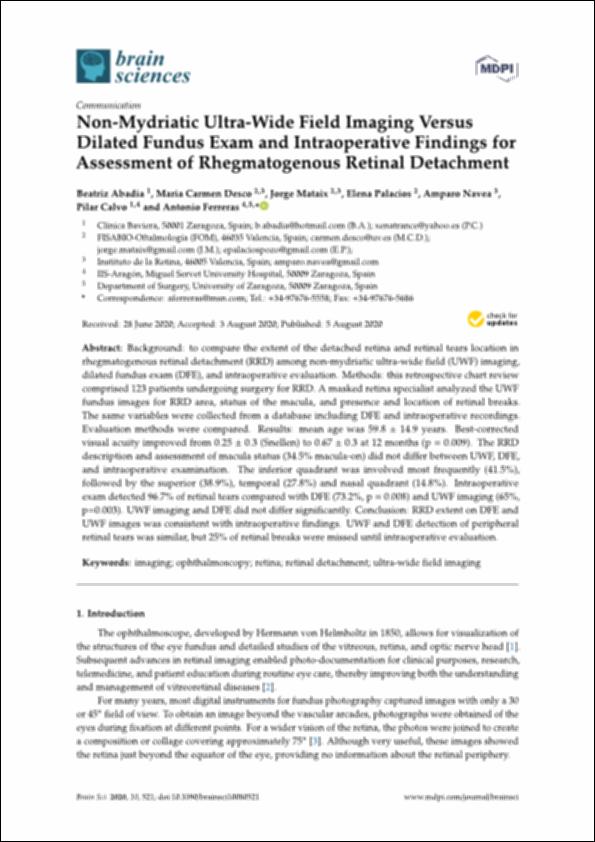Please use this identifier to cite or link to this item:
http://hdl.handle.net/10637/12864Non-mydriatic ultra-wide field imaging versus dilated fundus exam and intraoperative findings for assessment of rhegmatogenous retinal detachment
| Title: | Non-mydriatic ultra-wide field imaging versus dilated fundus exam and intraoperative findings for assessment of rhegmatogenous retinal detachment |
| Authors : | Abadía Álvarez, Beatriz Desco Esteban, María Carmen Mataix Boronat, Jorge Palacios Pozo, Elena Navea Tejerina, Amparo Calvo Pérez, Pilar Ferreras Amez, Antonio |
| Keywords: | Retina - Desprendimiento - Diagnóstico por imagen.; Retinal detachment - Imaging.; Retina - Diseases - Imaging.; Ophtalmoscopy.; Retina - Enfermedades - Diagnóstico por imagen.; Fondo de ojo - Exploración. |
| Publisher: | MDPI |
| Citation: | Abadia, B., Desco, M.C., Mataix, J., Palacios, E., Navea, A., Calvo, P. et al. (2020). Non-mydriatic ultra-wide field imaging versus dilated fundus exam and intraoperative indings for assessment of rhegmatogenous retinal detachment. Brain Sciences, vol. 10, i. 8 (05 aug.), art. 521. DOI: https://doi.org/10.3390/brainsci10080521 |
| Abstract: | Background: to compare the extent of the detached retina and retinal tears location in rhegmatogenous retinal detachment (RRD) among non-mydriatic ultra-wide field (UWF) imaging, dilated fundus exam (DFE), and intraoperative evaluation. Methods: this retrospective chart review comprised 123 patients undergoing surgery for RRD. A masked retina specialist analyzed the UWF fundus images for RRD area, status of the macula, and presence and location of retinal breaks. The same variables were collected from a database including DFE and intraoperative recordings. Evaluation methods were compared. Results: mean age was 59.8 14.9 years. Best-corrected visual acuity improved from 0.25 0.3 (Snellen) to 0.67 0.3 at 12 months (p = 0.009). The RRD description and assessment of macula status (34.5% macula-on) did not di er between UWF, DFE, and intraoperative examination. The inferior quadrant was involved most frequently (41.5%), followed by the superior (38.9%), temporal (27.8%) and nasal quadrant (14.8%). Intraoperative exam detected 96.7% of retinal tears compared with DFE (73.2%, p = 0.008) and UWF imaging (65%, p=0.003). UWF imaging and DFE did not di er significantly. Conclusion: RRD extent on DFE and UWF images was consistent with intraoperative findings. UWF and DFE detection of peripheral retinal tears was similar, but 25% of retinal breaks were missed until intraoperative evaluation. |
| Description: | Este artículo se encuentra disponible en la siguiente URL: https://www.mdpi.com/2076-3425/10/8/521 |
| URI: | http://hdl.handle.net/10637/12864 |
| Rights : | http://creativecommons.org/licenses/by/4.0/deed.es |
| ISSN: | 2076-3425 (Electrónico). |
| Issue Date: | 5-Aug-2020 |
| Center : | Universidad Cardenal Herrera-CEU |
| Appears in Collections: | Dpto. Medicina y Cirugía |
Items in DSpace are protected by copyright, with all rights reserved, unless otherwise indicated.


